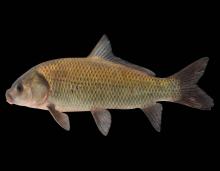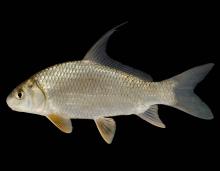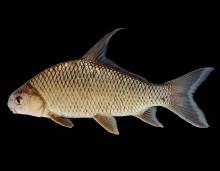Fishes
Media

Species Types
Scientific Name
Morone chrysops x M. saxatilis
Description
Hybrids between the striped bass and white bass are stocked by the MDC in select impoundments around the state. Also called "wipers," they attain a larger size than our native white bass.
Media

Species Types
Scientific Name
Lepisosteus osseus
Description
The longnose gar has a longer, narrower snout than our other three gars and is the most widely distributed gar in Missouri.
Media

Species Types
Scientific Name
Salmo trutta
Description
Native to Europe, hatchery-raised brown trout are stocked into cold streams and lakes in Missouri. A favorite of anglers, this species can reach 37 inches and 26 pounds.
Media

Species Types
Scientific Name
Sander vitreus
Description
MDC has been stocking walleye, a popular game fish, in lakes and reservoirs including Stockton, Lake of the Ozarks, Bull Shoals, and numerous other reservoirs.
Media

Species Types
Scientific Name
Percina caprodes
Description
The logperch occurs in small- to medium-sized rivers and along gravel shorelines in reservoirs. Our largest darter has a distinctly conical snout that overhangs the mouth, and 15 to 20 vertical dark bars on a light background.
Media

Species Types
Scientific Name
Lepomis microlophus
Description
The redear sunfish is deep and slab-sided, with a small mouth, with the upper jaw not reaching past the front of the eye. In natural waters, it is confined to the southern half of Missouri, but it is widely stocked in small reservoirs and ponds.
Media

Species Types
Scientific Name
Ictiobus niger
Description
Compared to Missouri’s other buffalofishes, the black buffalo is less abundant and widespread, and of the three, it occurs most often in places with strong currents.
Media

Species Types
Scientific Name
Carpiodes cyprinus
Description
Like our other carpsuckers, the quillback has a deep, rather thick body and a long, sickle-shaped dorsal fin. This silvery, hump-backed fish is widely distributed in Missouri.
Media

Species Types
Scientific Name
Catostomus commersonii
Description
The white sucker has fine scales and a short dorsal fin. The lips are covered with small bumps. A small-creek fish that occurs nearly statewide, but absent from the Bootheel lowlands and the southeastern Ozarks.
Media

Species Types
Scientific Name
Carpiodes velifer
Description
The highfin carpsucker is named for the remarkably long first principal ray of its dorsal fin. It is rare in Missouri and is a Species of Conservation Concern.
See Also


Media

Species Types
Scientific Name
Amphiuma tridactylum
Description
The three-toed amphiuma is an eel-like, completely aquatic salamander. It has very small forelimbs and hind limbs, each with three tiny toes. In Missouri it’s found only in the Bootheel region.
Media

Species Types
Scientific Name
Siren intermedia nettingi
Description
The western lesser siren is an eel-like, aquatic salamander with external gills, small eyes, small forelimbs with four toes, and no hind limbs. In Missouri, it’s found mostly in the Bootheel and northward in counties near the Mississippi River.
About Fishes in Missouri
Missouri has more than 200 kinds of fish, more than are found in most neighboring states. Fishes live in water, breathe with gills, and have fins instead of legs. Most are covered with scales. Most fish in Missouri “look” like fish and could never be confused with anything else. True, lampreys and eels have snakelike bodies — but they also have fins and smooth, slimy skin, which snakes do not.





















